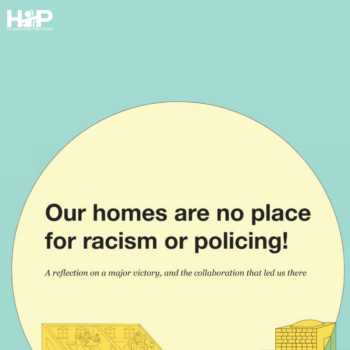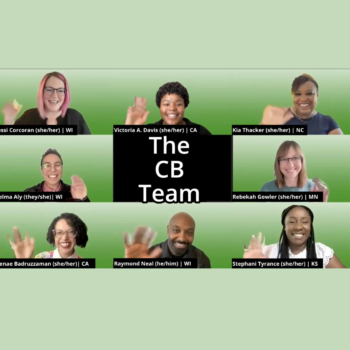| By Jonathan Heller |
A few months ago, I wrote about the need for public health practitioners who want to advance equity to explicitly address race and power in their work. I received positive feedback, but also found that people are interested in how to actually do this. I recently created some materials for a training and it went well.
So, here goes an attempt to share it with a broader audience…
Let’s say you and your team – a team that hopefully includes people with a variety of skill sets and perspectives, including people from communities facing inequities – are working on a project on a particular social determinant of health in a particular location. As an example, let’s use policing, and mass incarceration more generally (i.e., the determinant), in Cincinnati and Akron, Ohio (i.e., the location). (Disclaimer, these examples stem from a recent HIA HIP released).
Questions about Underlying Issues
As you begin thinking about your project, here are a set of strategic questions that you can discuss with the team that get at the underlying issues of racism and power that are at play for virtually all social determinants of health:
1. What is your long-term equity goal, as it relates to the issue in that place?
2. What is the historical and current racial context for the issue, at the structural, institutional, and interpersonal levels?
3. What is the historical and current context with regard to other forms of oppression (class, gender, age, sexual orientation, disability, etc.) for the issue at the structural, institutional, and interpersonal levels?
4. Have race and/or other forms of oppression been used as political tools in decision making around the issue? If so, how?
5. Do you have the votes or other measures of buy-in to advance your equity goal? Explain.
6. Do you have a network of organizations and individuals strong enough to advance your equity goal? Explain.
7. What is the current societal narrative as it relates to your equity goal? Does it work in your favor or against you?
Example: Here are some quick and oversimplified answers for policing in Ohio:
1. Long-term equity goal? Eliminate the use of policing and incarceration as a form of control of black communities. Invest in necessary jobs, housing, education, etc. instead.
2. What is the racial context for the issue? FDR’s compromise with southern Democrats, who were segregationist (interpersonal racism), led to housing policies at HUD that have allowed whites to build wealth and simultaneously led to white flight and disinvestment from inner cities (institutional racism). Many communities of color, like those in Cincinnati and Akron, now suffer from lack of opportunity – in jobs, housing, education, etc. – and high crime rates (systemic racism). This has led to excess policing and incarceration. Listen to this NPR piece, for example, for more details.
3. What other context and forms of oppression are important to consider? The following populations have also been over-policed in communities of color and other communities: youth, men, LGBTQ, those with mental illness, and low-income whites.
4. How have race and other forms of oppression been used as political tools? Think of who the language of “tough on crime”, “war on drugs”, “super-predators” was really about (dog-whistling). Think about how heroin addiction – which is thought to be used more by whites – is treated as a health issue, in comparison to crack addiction – which is thought to be used more by blacks – which is criminalized.
5. Do we have enough votes or buy-in to advance our equity goal? No! Most people – including people of color – consider policing to be the best solution to addressing public safety needs in inner-city communities of color.
6. Do we have a network of organizations strong enough to advance our equity goal? No! This issue is just beginning to bring people together and a movement is starting. But still, policing and incarceration are seen as separate issues from jobs, housing, and education. We are still too siloed in our work.
7. What is the current narrative? It includes “Be afraid of black people”, “us vs them”, “individuals are at fault – they choose to commit crimes and are bad people”, “punishment deters crime”, and “we are protecting the innocent”. We see these themes everywhere – in the news, on TV, and in the movies. There is a lot more that could be said about this, but the way crime and policing are now thought of, we will have a difficult time achieving significant reforms.
After going through this exercise, your team will most likely have a better and a common understanding of the barriers you face in achieving your equity goal. That understanding should inform the approach you take.
Questions to Overcome Barriers Identified
If your project includes conducting research, like a Health Impact Assessment, a next step is to think about how you can use your research process to overcome these barriers. For example, your team could discuss the following questions.
How can you use your research process to:
1. Bring attention to the current and historical context regarding racial and other forms of oppression around your issue?
2. Unite people across the boundaries of race and other forms of oppression?
3. Diffuse the ability of opponents to use race or other forms of oppression as a political tool to block your ability to move your equity goal?
4. Build your ability to advance both your short-term and long-term equity goals by:
a. Winning enough votes or other measures of buy-in?
b. Building relationships and infrastructure to change what is on the political agenda?
c. Changing the dominant narrative related to your issue?
Example: Again, here are some quick and oversimplified answers for policing in Ohio:
1. How can we bring attention to the current and historical context of oppression? We can: discuss these with our steering committee; reflect them in our recommendations (e.g., recommend that communities come together to talk about this history); and have a section in our report that discusses this history.
2. How can we unite people across boundaries? We can discuss how both black communities and the police are negatively impacted by current forms of policing. And we can use the steering committee to start bringing people together and build trust.
3. How can we diffuse the ability of opponents to use oppression as a political tool? We can discuss approaches to overcoming dog-whistling during our research process. We can make recommendations about further and broader discussions about the use of race as a political tool as it relates to policing. We can also share information about how unconscious bias plays out today in terms of policing.
4. a. How can we build our ability to win enough votes or gain buy-in? We can use the HIA process to engage communities most impacted and help our partners build their leadership and sense of agency.
b. How can we build our relationships and infrastructure? By developing and engaging a diverse steering committee.
c. How can we use the research process to change the dominant narrative? This is hard! We can start to change the “us vs them” mentality by discussing that we are all impacted. We can humanize everyone. We can talk about wanting to have policies that improve everyone’s health and that address underlying social causes.
As you can see, these are difficult questions and advancing equity by addressing race and power is not easy. But this work is necessary and it is worth struggling – together – to figure out how to do it.
Tools You Can Use
In case it is useful, we’ve pulled these questions together as a worksheet to use with your team. And for HIA practitioners, after you go through these questions, you may want to use the Equity Metrics for HIA Practice as a planning tool for your project.
Let us know if you use these tools and, if so, what feedback you have for us! Thanks!




